Change file extension in windows 7. Correctly changing file extensions in Windows
Every day we have to work with various files, which are contained on the computer. Almost every one of them has an extension. But not all users pay attention to it and do not understand why it is needed. Moreover, not everyone knows how to change the file extension. In fact it has very great importance. For example, it can tell the user about the approximate contents of a file that it may contain) and even suggest in which program it is better to open it. Also myself operating system identifies the files it contains based on the extension specified in them.
What does the extension look like?
It is indicated as a few characters at the end of the file name. Usually there are three or four of them and they always come after the dot. Example: ".mp3" or ".doc". In the first case, the title immediately makes it clear that we are talking about musical content, in the second, as is immediately clear to many, it is presented Text Document. And both files open in different programs. Various players will be suitable for the first, the second will open in. On some computers, the extension is not shown, but this does not mean that the files do not have one. The display function is simply not enabled in the settings. The question arises, how to change the file extension in this case? To do this, you will first have to look at the appropriate paragraph.
VWindows 7
If the display of such information is disabled, you can change this through a small item in the settings. In Windows 7, the path to the desired action is through the Control Panel. Next, you need to go to the folder options section. The window that opens will contain a View tab. That's what you'll need. There is an item here that allows you to hide file extensions. To cancel this rule, you need to uncheck the box next to it, and then save the changes by clicking “ok”. That's it, from now on everything will be displayed correctly.
Now you can go directly to the question of how to change file extensions. In this operating system, this process is very simple. But there is a small nuance: initially (according to the developers - for the sake of convenience), the function that allows you to change file extensions in Windows 7 is disabled. This can cause difficulties when a user downloads an archive, song or book, and it is accidentally saved in the wrong extension. The previous paragraph describes in detail how to deal with this problem. Now all that remains is to select the file name and write correct extension.
Important: if you inadvertently remove a file extension (instead of renaming it), the system will be in trouble. The computer will not know which program to open this file with. As a result, this will not be possible. You can fix this by highlighting the name again and entering what you think is the correct extension. Don't forget to put a dot between it and the title itself. Also, when changing file names, you should be especially careful and not delete the unnecessary ones (what comes after the period and itself), otherwise history will repeat itself. Not good experienced users After the changes have been made, it is better to set “hide extensions” in the settings again. In this way, accidental actions can be prevented.
Files without extension
Now you know that there is nothing complicated in the task of changing a file extension on a computer. It remains to talk about the files in which it is missing. Surely everyone has at least once encountered such a problem as the inability to open them.
The computer assistant usually offers two solutions to the problem: search similar files on the Internet or manually select a program. The first method can be abandoned immediately due to its ineffectiveness. But the second one is quite within the capabilities of any user. By selecting it, you will see a window with available programs. Of these, you need to choose the most suitable one, but if it is not on the list, you should find it yourself. There is a “review” button for this.
File extensionis part of the file name separated from the main name by a dot. There are many file format extensions. And in order for the operating system to determine which program to open a certain file, its extension is placed after the file name.
For example, file Landscape.jpg, jpg extension indicates that this is graphic file and it can be opened by any standard or third-party graphic editor or an image viewer.
I will give examples of some categories of files and their extensions.
| Audio files | mp2, mp3, wav, midi, mpa, ogg, wma |
| Video files | 3fp, avi, flv, mkv, mov, mp4, mpeg, wmv |
| Raster images | bmp, jpeg, jpg, png, tif, zif |
| Text, documents | doc, docx, txt, xps, readme, fb2, emlx, bdr |
Every program on a computer is designed to work with certain files and extensions. Therefore, if you want to open any file, then first you need to find out which program uses the extension of this file, then download it and install it.
Change file extension in windows 7possible for different purposes. For example for bat creation, html, xml files. Each person interested in this issue has his own goal, but the general task is to change the file extension.
So let's get started. To change the file extension, follow these steps:
First, you need to make sure that the file extension is displayed.
Step 1 . Click Start and select Control Panel. To more fully display all components of the control panel, change view of small or large icons . Then click on the link.

Step 2 . In the window that opens, go to the tab View. In the block Extra options drag the slider down and uncheck the box Hide extension for registered file types. After that, click on the button OK.

The need to change the file extension occurs if initially or when saving it was mistakenly assigned the wrong format name. Additionally, there are cases where elements with different extensions essentially have same type format (for example, RAR and CBR). And in order to open them in specific program, you can simply change it. Let's look at how to perform this task in Windows 7.
It is important to understand that simply changing the extension does not change the file type or structure. For example, if you change the filename extension in a document from doc to xls, it will not automatically become an Excel table. To do this, you need to carry out a conversion procedure. In this article we will look at various ways changing the format name. This can be done using the built-in Windows tools, and using third-party software.
Method 1: Total Commander
First of all, let's look at an example of changing the name of an object format using third party applications. Almost anyone can handle this task file manager. The most popular of them, of course, is.
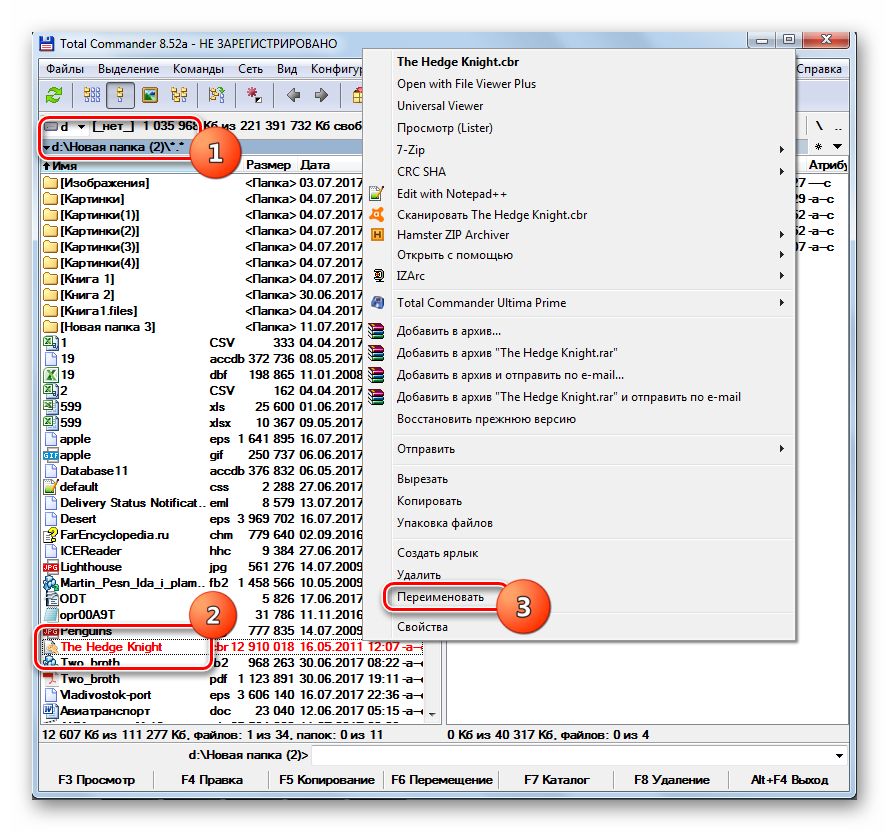

WITH using Total Commander can perform bulk renaming.
- First of all, you should select those elements that need to be renamed. If you need to rename all files in a given directory, then stand on any of them and use the combination Ctrl+A or Ctrl+Num+. Also, you can go to the menu by item "Selection" and select from the list "Select all".

If you need to change the name of the file type for all objects with a certain extension in a given folder, then in this case, after selecting the element, sequentially go through the menu items "Selection" And “Select files/folders by extension” or apply Alt+Num+.

If you need to rename only part of the files with a certain extension, then first sort the contents of the directory by type. This will make it easier to search necessary objects. To do this, click the field name "Type". Then, holding down the key Ctrl, left-click ( LMB) by those names of elements whose extension needs to be changed.

If the objects are arranged in order, then click LMB on the first of them, and then, holding Shift, according to the last one. This will select the entire group of elements between these two objects.

Whichever selection option you choose, the selected objects will be marked in red.
- After this, you need to call the bulk renaming tool. This can also be done in several ways. You can click on the icon « Bulk renaming»
on the toolbar or apply Ctrl+M(for English versions Ctrl+T).

The user can also click "File", and then select from the list "Group renaming".
- The tool window opens "Group renaming".
- In field "Extension" just enter the name that you want to see for the selected objects. In field "New name" at the bottom of the window, options for the names of the elements in a renamed form will immediately be displayed. To apply the change to specified files, click "Run".
- After this you can close the window group change titles. Through the Total Commander interface in the field "Type" you can see that those elements that were previously selected have changed to the user-specified extension.
- If you find out that you made a mistake when renaming or for some other reason you wanted to cancel it, then this is also quite easy to do. First of all, select files with changed names using any of the methods discussed above. After that, move to the window "Group renaming". In it, click "Rollback".
- A window will open asking if the user really wants to cancel. Click "Yes".
- As you can see, the rollback was completed successfully.







Method 2: Bulk Rename Utility
In addition, there are special programs, intended for mass renaming objects that also operate in Windows 7. One of the most famous such software products is Bulk Rename Utility.
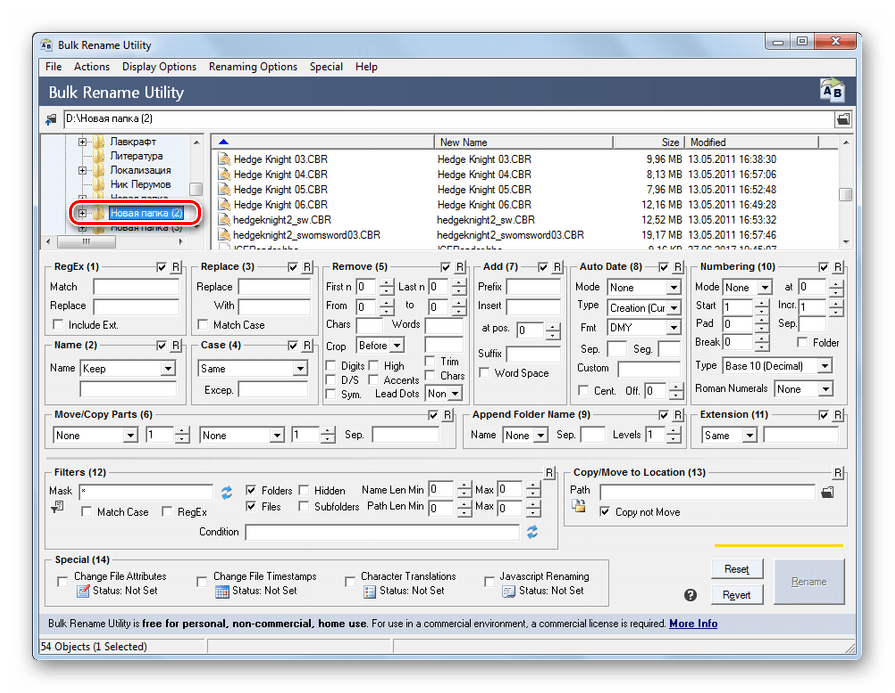

Main disadvantage this method The problem is that the Bulk Rename Utility application is not Russified, which creates certain inconvenience for the Russian-speaking user.
Method 3: Using Explorer
The most popular way change filename extension is to use " Windows Explorer" But the difficulty is that in Windows 7, by default, extensions in Explorer are hidden. Therefore, first of all, you need to activate their display by going to “Folder Options”.
- Go to any folder in Explorer. Click "Arrange". Next in the list, select "Folder and Search Options".
- The “Folder Options” window opens. Move to section "View". Uncheck the box "Hide extensions". Click "Apply" And "OK".
- Now the format names will be displayed in Explorer.
- Then go in Explorer to the object whose format name you want to change. Click on it RMB. Select from the menu "Rename".
- If you do not want to call up the menu, then after highlighting an element, you can simply press the key F2.
- The file name becomes active and available for change. We change the last three or four letters after the period in the name of the object with the name of the format that needs to be applied. The rest of his name does not need to be changed unless absolutely necessary. After performing this manipulation, press Enter.
- A miniature window opens, informing you that after changing the extension, the object may become inaccessible. If the user consciously performs actions, then he must confirm them by pressing "Yes" after the question “Perform the change?”.
- Thus, the name of the format was changed.
- Now, if there is such a need, the user can again go to “Folder Options” and remove the display of extensions in “Explorer” in the section "View" by checking the box next to the item "Hide extensions". Now you should click "Apply" And "OK".









Method 4: "Command Line"
You can also change the filename extension using the interface " Command line».
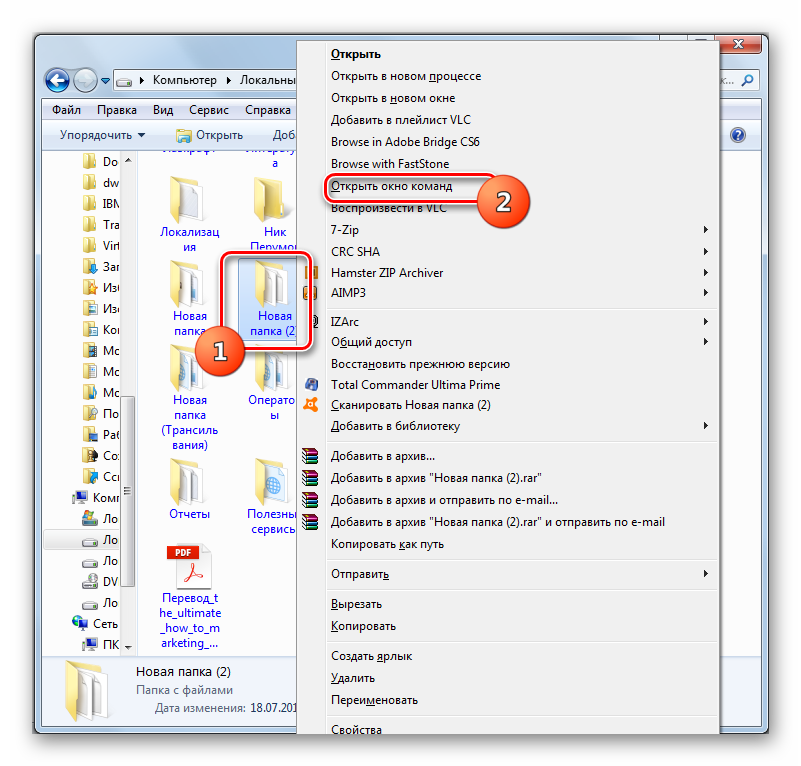

But, of course, using the Command Line to change the filename extension of only one file is not rational. It is much easier to carry out this procedure through Explorer. It’s another matter if you need to change the format name of an entire group of elements. In this case, renaming through Explorer will take a lot of time, since this tool does not provide for performing an operation simultaneously with an entire group, but the “Command Line” is suitable for solving this task.
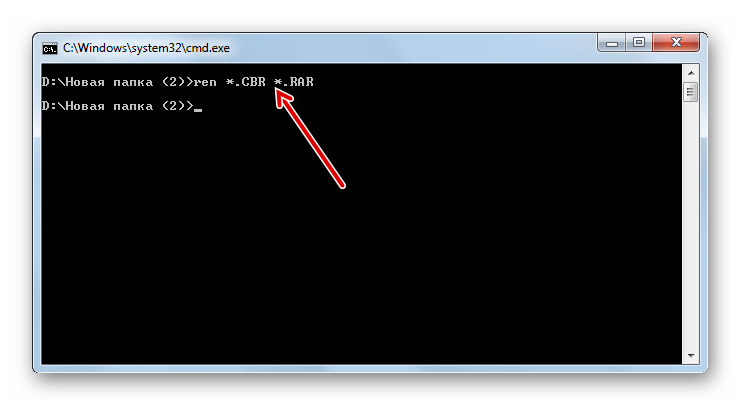

Using the Command Line, you can solve more complex tasks when changing the extension of elements located in the same folder. For example, if you need to rename not all files with a certain extension, but only those that have a certain amount of characters, you can use “?” instead of each character. That is, if the “*” sign denotes any number of characters, then the “?” implies only one of them.
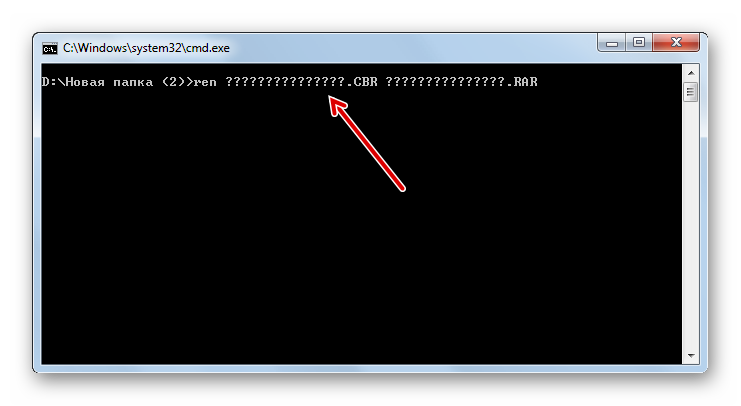
As you can see, there are several options for changing extensions in Windows 7. Of course, if you need to rename one or two objects, the easiest way to do this is through the Explorer interface. But, if you need to change the format names of many files at once, then in this case, in order to save effort and time in performing this procedure, you will have to either install third-party software or use the capabilities provided by the Windows Command Line interface.
We are glad that we were able to help you solve the problem.
In contact with
Or documents into a format that can be read by an electronic device, reformat text into a web page, or perform other actions. In such cases, it will be useful to know how to change the file extension in Windows 7.
What it is
IN electronic devices recorded information is stored in different formats, which are identified by the file extension. This is a combination of 3-4 characters at the end of the document name (for example, xxx.htm, xxx.docx, xxx.jpg and others). In this way, the operating system automatically evaluates what data type the document is and which application should open it.
In order for the program selected by the system to decrypt data, it is important to accurately perform the sequence of operations and set the format correctly. Otherwise, you can lose information, so decoding it will become impossible.
How to change the file extension
The data format may be hidden from the Windows user by default. Therefore, before changing the file extension, you first need to display it. To do this, appropriate changes are made in the settings.
- Click "Start"
- Go to the “Control Panel” section.
- For ease of use, it is better to set the viewing mode to “Small icons”. It can be found at the top of the menu that opens.
- Next, go to the “Folder Options” section.

- Open the "View" tab.
- In the “Advanced Options” menu, find the “Hide extensions for known file types” option and uncheck the box. Then click “Apply” and OK.

